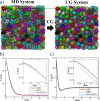Introducing Memory in Coarse-Grained Molecular Simulations
- PMID: 33982567
- PMCID: PMC8154603
- DOI: 10.1021/acs.jpcb.1c01120
Introducing Memory in Coarse-Grained Molecular Simulations
Abstract
Preserving the correct dynamics at the coarse-grained (CG) level is a pressing problem in the development of systematic CG models in soft matter simulation. Starting from the seminal idea of simple time-scale mapping, there have been many efforts over the years toward establishing a meticulous connection between the CG and fine-grained (FG) dynamics based on fundamental statistical mechanics approaches. One of the most successful attempts in this context has been the development of CG models based on the Mori-Zwanzig (MZ) theory, where the resulting equation of motion has the form of a generalized Langevin equation (GLE) and closely preserves the underlying FG dynamics. In this Review, we describe some of the recent studies in this regard. We focus on the construction and simulation of dynamically consistent systematic CG models based on the GLE, both in the simple Markovian limit and the non-Markovian case. Some recent studies of physical effects of memory are also discussed. The Review is aimed at summarizing recent developments in the field while highlighting the major challenges and possible future directions.
Conflict of interest statement
The authors declare no competing financial interest.
Figures




References
-
- Brini E.; Algaer E. A.; Ganguly P.; Li C.; Rodríguez-Ropero F.; van der Vegt N. F. A. Systematic coarse-graining methods for soft matter simulations – a review. Soft Matter 2013, 9, 2108–2119. 10.1039/C2SM27201F. - DOI
-
- Schütte Ch; Sarich M. A critical appraisal of Markov state models. Eur. Phys. J.: Spec. Top. 2015, 224, 2445–2462. 10.1140/epjst/e2015-02421-0. - DOI
-
- Rudzinski J. F. Recent Progress towards Chemically-Specific Coarse-Grained Simulation Models with Consistent Dynamical Properties. Computation 2019, 7, 42.10.3390/computation7030042. - DOI
Publication types
LinkOut - more resources
Full Text Sources
Other Literature Sources

